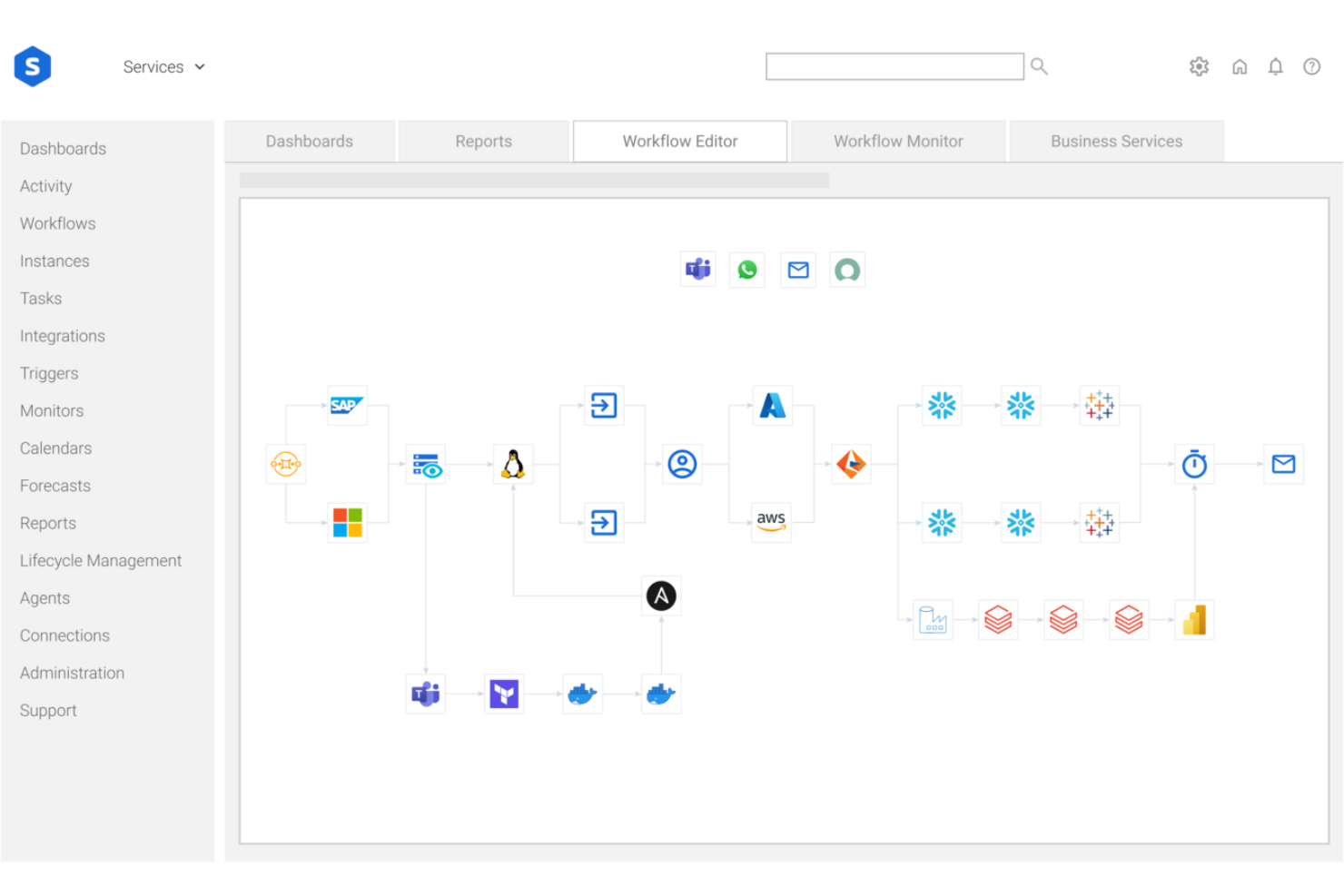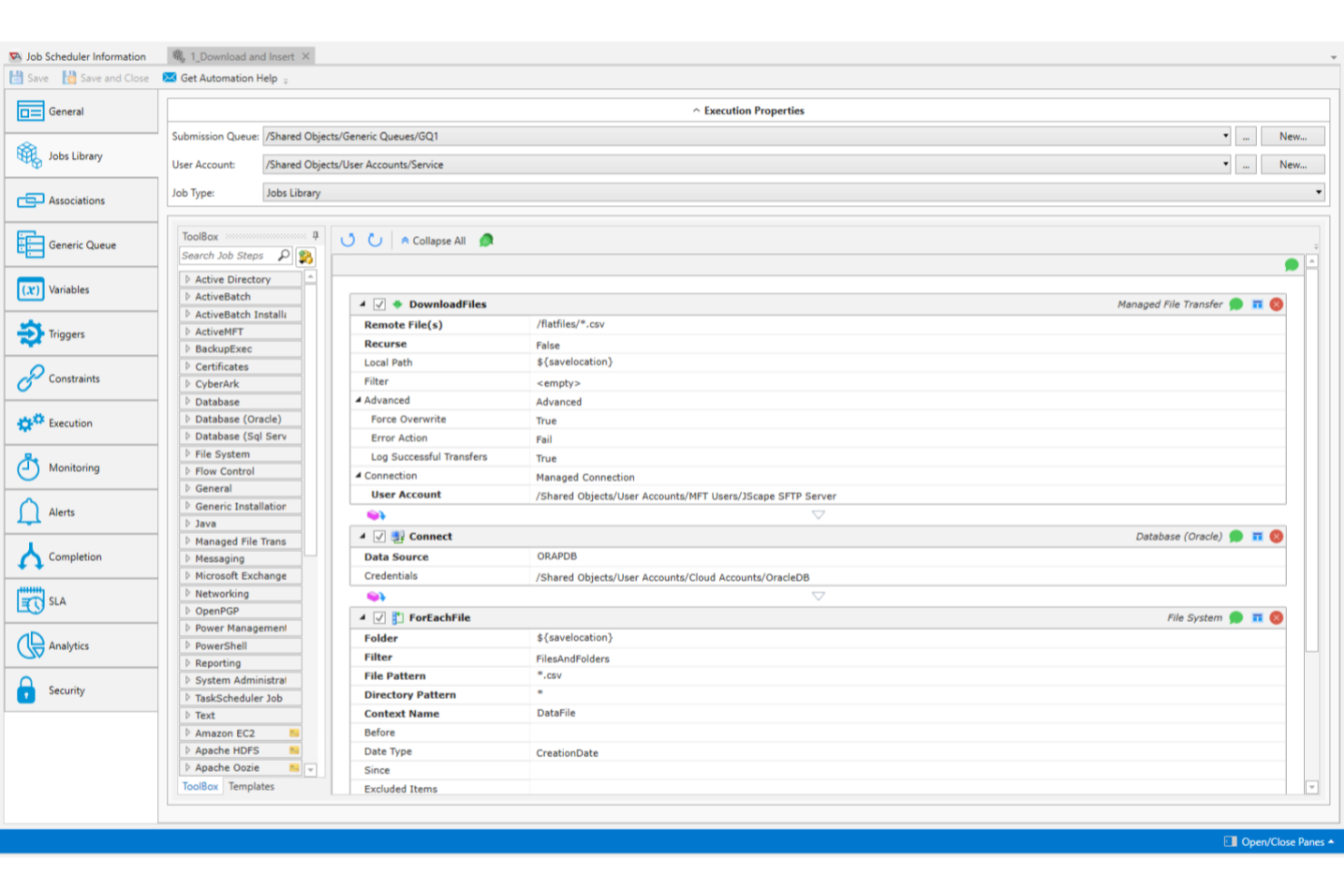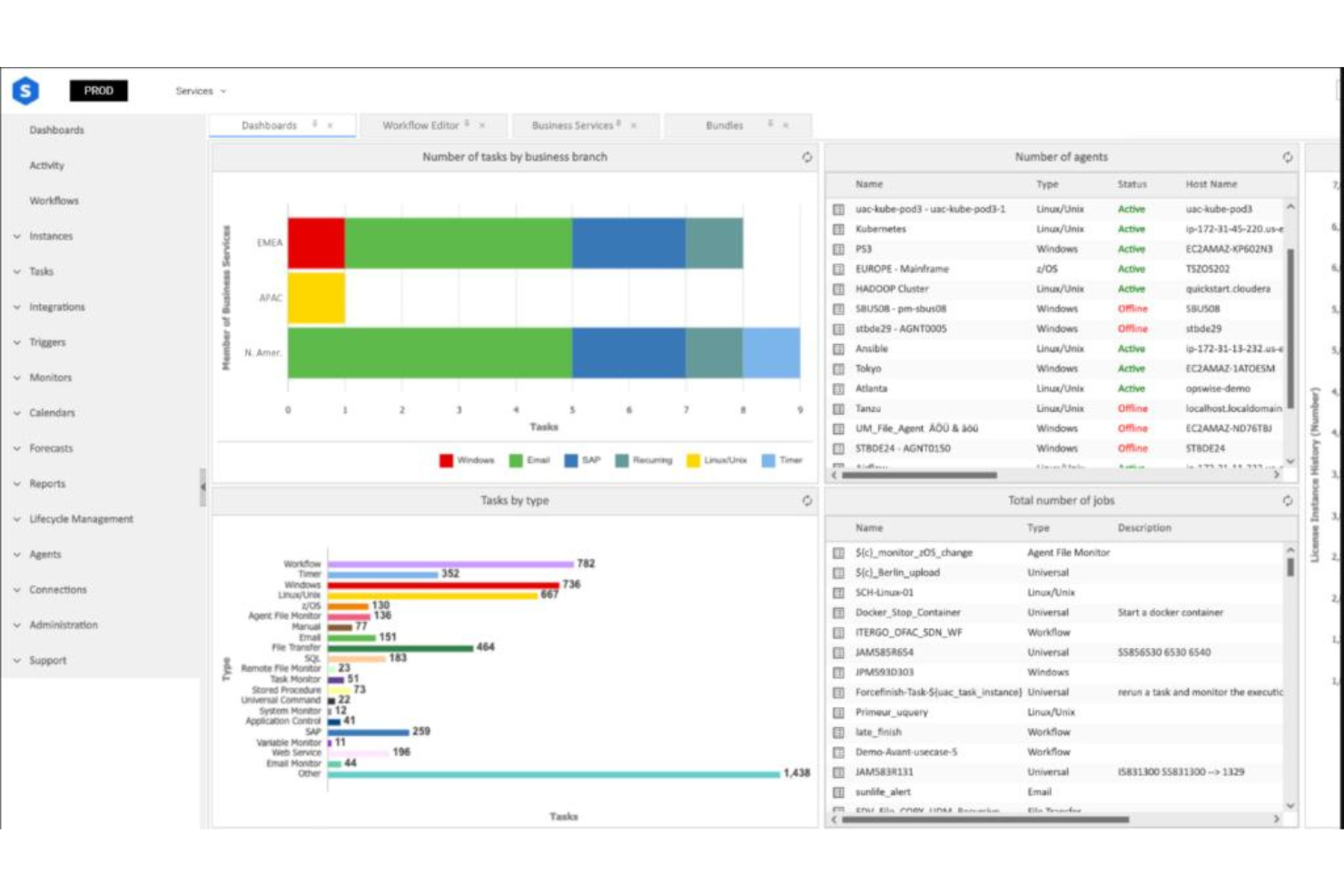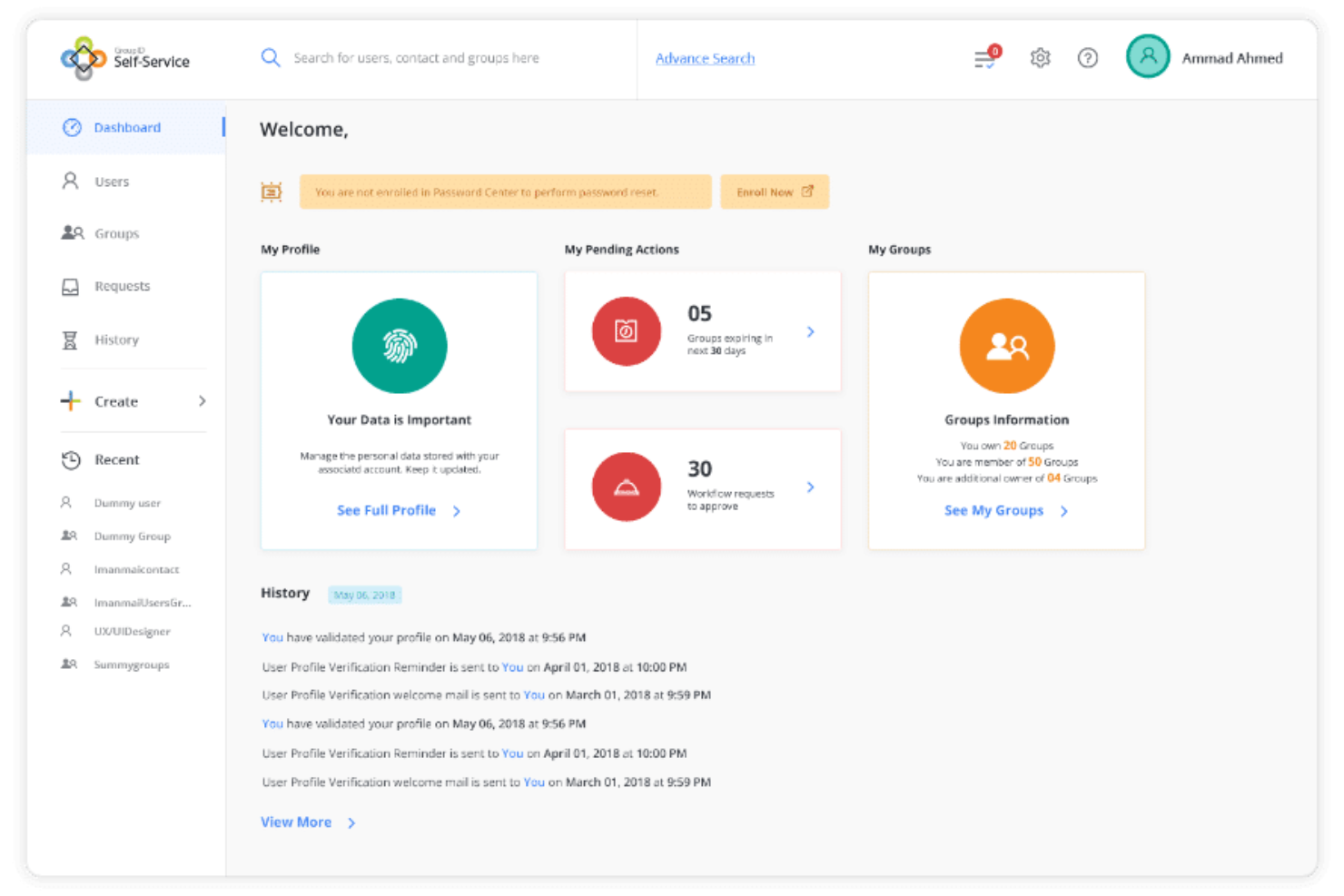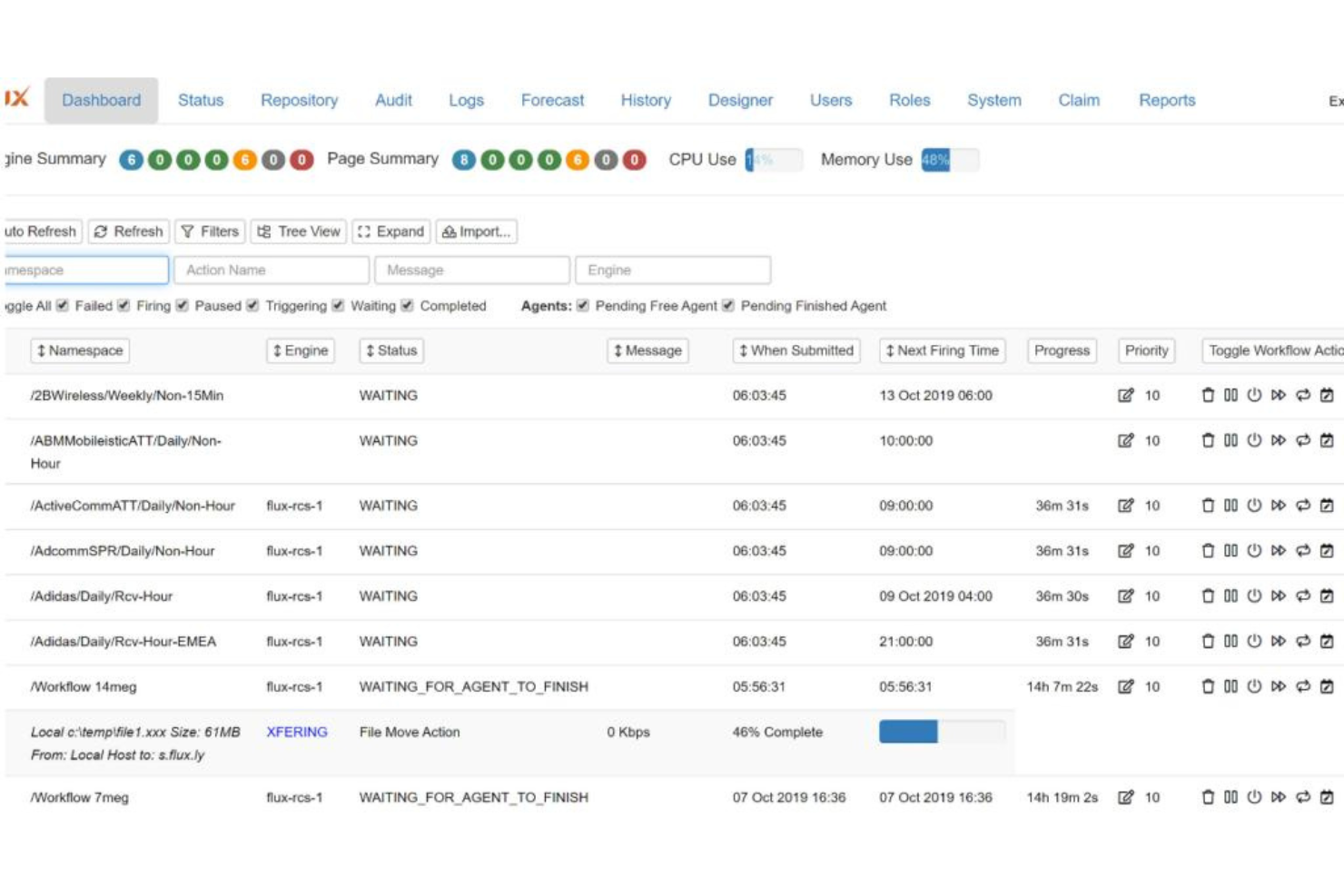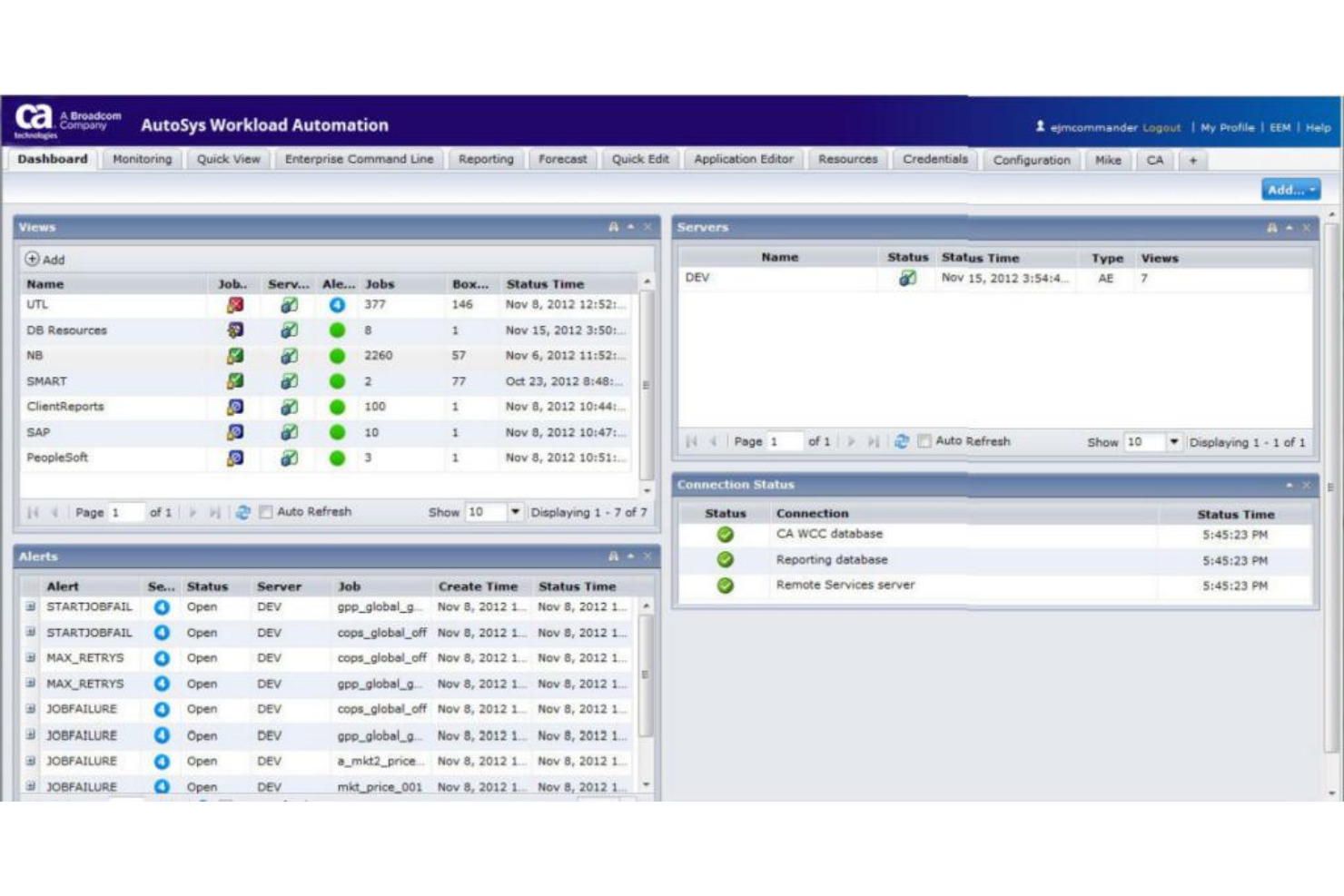10 Best Workload Automation Software Shortlist
Here's my pick of the 10 best software from the 20 tools reviewed.
Our one-on-one guidance will help you find the perfect fit.
In the realm of workload automation, I've delved into both on-premises and cloud-based automation platforms, acknowledging their role in weaving batch processes with critical business applications like ERP and CRM. Often positioned as low-code or no-code SaaS solutions, these tools empower IT teams to optimize complex workflows in hybrid environments, manage batch jobs, and streamline data pipelines in data centers.
With a strong emphasis on SLAs, enterprise workload automation integrates seamlessly with various operating systems, balancing workloads in cloud and on-premises settings. Whether it's about managed file transfer (MFT), provisioning, or leveraging machine learning, the end game remains clear: optimized resource management and efficient handling of tasks, bridging the traditional and the modern with ease.
What Is A Workload Automation Software?
Workload automation software is a digital solution designed to manage, schedule, and execute a series of predefined tasks within IT environments. Typically utilized by IT professionals, systems administrators, and enterprises, its primary purpose is to enhance efficiency by orchestrating complex operations, eliminating the need for manual intervention, and ensuring tasks are completed with consistency and precision.
Best Workload Automation Software Summary
| Tool | Best For | Trial Info | Price | ||
|---|---|---|---|---|---|
| 1 | Best for real-time workload automation | Free demo available | Pricing upon request | Website | |
| 2 | Best for ease of use and low-code/no-code integration with disparate systems | Free demo available | Pricing upon request | Website | |
| 3 | Best for SaaS workload automation with lightweight, self-updating agents | Free demo available | Pricing upon request | Website | |
| 4 | Best for real-time workload automation | Free demo available | Pricing upon request | Website | |
| 5 | Best for customizable enterprise scheduling | Not available | Pricing upon request | Website | |
| 6 | Best for streamlined cross-application tasks | Not available | Pricing upon request | Website | |
| 7 | Best for active directory automation tasks | Not available | Pricing upon request | Website | |
| 8 | Best for comprehensive task scheduling and automation | Not available | Pricing upon request | Website | |
| 9 | Best for orchestration across platforms and containers | Not available | Pricing upon request | Website | |
| 10 | Best for diverse IT infrastructure support | Not available | Pricing upon request | Website |
-

Docker
Visit WebsiteThis is an aggregated rating for this tool including ratings from Crozdesk users and ratings from other sites.4.6 -

Pulumi
Visit WebsiteThis is an aggregated rating for this tool including ratings from Crozdesk users and ratings from other sites.4.8 -

GitHub Actions
Visit Website
Best Workload Automation Software Reviews
Best for real-time workload automation
Stonebranch Universal Automation Center (UAC) is a real-time IT automation platform that helps you manage and orchestrate tasks and processes across hybrid IT environments, from on-premises systems to the cloud. It enables you to automate both IT and business processes, securely handle file transfers, and centralize the management of various job scheduling and workload automation tools.
Why I Picked Stonebranch Universal Automation Center: One reason I chose Stonebranch UAC is its robust workflow orchestration capabilities. You can visually design automation workflows that span on-premises, private cloud, and public cloud applications and platforms. This feature allows your team to create both simple and complex workflows using an intuitive drag-and-drop interface, ensuring seamless coordination across diverse environments. It also supports event-driven automation. This means you can set up real-time triggers that respond to specific events across your IT infrastructure, moving beyond traditional batch processing.
Standout features & integrations:
Other features include self-service automation, which empowers your team members to manage automation tasks independently through defined roles and permissions, reducing reliance on centralized IT support. The platform also offers centralized operational control with proactive monitoring, reporting, and alerts.
Some integrations include Ansible, Git, GitHub, HashiCorp Terraform, Apache Airflow, Apache Kafka, AWS CLI, AWS Mainframe Modernization, AWS Step Functions, Microsoft Teams, Oracle Job Scheduler, and Salesforce.
Pros and cons
Pros:
- Efficient management of complex workflows across platforms
- Centralized control enhances operational visibility
- Flexible deployment options
Cons:
- Initial setup can be complex due to intricate infrastructure.
- Learning curve for new users may be steep
Best for ease of use and low-code/no-code integration with disparate systems
ActiveBatch stands out as a robust workload automation solution designed to bridge the gap between varied systems and platforms. Its prowess lies in creating cohesive workflows across different technological environments, directly aligning with its reputation for effective system integration.
Why I Picked ActiveBatch: Among the myriad of tools I sifted through, ActiveBatch solidified its place on my list because of its remarkable integration capabilities and ease of use. It offers a robust library of connectors so you can connect all your business-critical systems and applications. It also facilitates workflow development with no-code/low-code drag-and-drop GUI and a library of pre-built job steps and variables.
Standout features & integrations:
ActiveBatch offers a visual workflow designer that eliminates the need for scripting, turning intricate processes into more manageable tasks. Coupled with its event-driven architecture, it ensures timely and relevant task execution.
On the integration front, it offers connectors for a multitude of systems, from cloud platforms like AWS and Azure to databases such as SQL Server and Oracle. You can also get infinite extensibility to third-party services and applications with its Super REST API adapter.
Pros and cons
Pros:
- Visual workflow designer simplifies task orchestration
- Event-driven architecture for responsive task execution
- Wide range of connectors for varied platforms and databases
Cons:
- A steep learning curve for those unfamiliar with automation tools
- The pricing structure could benefit from more clarity
- Some users might find its array of features daunting
Best for SaaS workload automation with lightweight, self-updating agents
RunMyJobs is a SaaS-based workload automation platform designed to assist enterprises in automating a wide range of IT and business processes. It provides capabilities for SAP job scheduling, file transfer automation, finance automation, and other workload automation needs. It's a premium-certified SAP Endorsed App and included in the RISE with SAP reference architecture, making it ideal for those looking for less risk and long-term reliability.
Why I Picked RunMyJobs: The tool offers a library of prebuilt integrations, allowing for connections to various applications, systems, and services. It emphasizes the ability to automate business-critical processes with lightweight, self-updating agents in on-premises, cloud, or hybrid environments. RunMyJobs provides end-to-end visibility and control over these automated processes, with features such as real-time monitoring and predictive SLA notifications.
Standout features & integrations:
RunMyJobs offers event-driven automation to create and orchestrate business processes that can be triggered by real-time events or data. It's also a low-code development platform with an extensive library of templates and wizards.
The platform integrates with Amazon S3, Azure, Boomi, Box, Datasphere, Databricks, ServiceNow, SAP ERP, SAP S/4HANA, Snowflake, SharePoint, and more.
Pros and cons
Pros:
- Resilient architecture for system outages
- Efficient incident creation for triggered alerts
- Ability to handle heavy loaded scenarios
Cons:
- Learning curve for users new to automation
- Dashboard could be improved
Stonebranch provides a comprehensive solution dedicated to orchestrating, executing, and automating tasks across varied environments. Its inherent strength in real-time workload automation makes it a valuable asset for businesses that prioritize instantaneous task management and automation.
Why I Picked Stonebranch: Upon closely examining several tools, I judged Stonebranch to be a stand-out, primarily due to its proficiency in real-time automation. My decision to include Stonebranch in this list is rooted in its distinct approach to instantaneously addressing workload demands.
Standout features & integrations
Stonebranch's Universal Automation Center offers a unified platform to control workloads across various enterprise applications and systems. This holistic view is complemented by its Universal Controller, which delivers precise task scheduling.
When it comes to integrations, Stonebranch can interact with systems like SAP, Oracle, and mainframe environments, ensuring a broad scope of automation.
Pros and cons
Pros:
- Extensive integration capabilities with major enterprise systems
- Precise scheduling with the Universal Controller
- Universal Automation Center offers comprehensive task control
Cons:
- Customization options might be limited for specific use cases.
- The user interface might appear complex for certain tasks
- The learning curve for new users can be steep
Vinzant Software Global ECS offers a powerful scheduling platform designed to cater to the diverse needs of enterprises. As businesses grow and their processes become intricate, this tool demonstrates its proficiency in providing tailored scheduling solutions, aligning with its tagline of being the best for customizable enterprise scheduling.
Why I Picked Vinzant Software Global ECS: I determined Vinzant Software Global ECS to be a noteworthy inclusion in the list after closely comparing its capabilities with other scheduling tools. Its flexibility in accommodating specific enterprise requirements sets it apart from the rest.
Standout features & integrations
The platform stands out with its dynamic scheduling algorithms that can adjust to changing business requirements. Furthermore, its built-in audit trails provide transparency in scheduling decisions and actions.
When it comes to integrations, Vinzant Software Global ECS boasts compatibility with a broad spectrum of enterprise software, ensuring a cohesive workflow across different applications.
Pros and cons
Pros:
- Broad software integration capabilities
- Built-in audit trails enhance transparency
- Dynamic scheduling algorithms that cater to evolving needs
Cons:
- Potential for too many features that might overwhelm smaller enterprises.
- Customization can require additional setup time
- Might have a steeper learning curve for some users
Tidal is a workload automation platform that adeptly ties together various applications, creating a cohesive flow of tasks across different systems. Its emphasis on bridging gaps between diverse applications makes it a champion for ensuring streamlined cross-application undertakings.
Why I Picked Tidal Workload Automation: Navigating the vast sea of tools, Tidal Workload Automation caught my attention and anchored itself firmly on my list. In selecting and comparing, this tool differentiated itself with its distinct ability to simplify the maze of cross-application workflows. Reflecting upon its functionalities, I'm convinced it's truly best for those in search of an efficient cross-application taskmaster.
Standout features & integrations
At its core, Tidal Workload Automation boasts a user-friendly interface that facilitates easy scheduling and management of tasks, reducing the need for complex scripting. This is bolstered by its smart analytics capabilities that provide actionable insights into workflow patterns.
Integration-wise, it ties in with prominent platforms like SAP, Oracle, and Microsoft, ensuring that tasks flow smoothly across different technological environments.
Pros and cons
Pros:
- Intuitive user interface simplifies task management
- Powerful analytics provide valuable workflow insights
- Strong integration capabilities with major platforms
Cons:
- May require initial training for optimal usage
- Pricing details could be more transparent for prospective users
- Some advanced features might be overwhelming for beginners
Imanami Automation is a robust platform that focuses primarily on simplifying and automating tasks related to active directories. The tool recognizes the intricacies of active directory management and is tailored to ensure that companies can streamline such tasks with precision.
Why I Picked Imanami Automation: When choosing tools, I judge them based on their capacity to fulfill a specific niche effectively. Imanami Automation clearly stood out in this regard. The tool offers a unique approach to active directory tasks, which many other tools don't focus on as intensely.
Standout features & integrations
One of the remarkable features of Imanami Automation is its self-service capabilities, empowering users to handle tasks without always requiring IT intervention. It also offers detailed reporting tools that provide insights into directory changes and patterns.
Integration-wise, Imanami Automation smoothly connects with common IT management platforms and directory services, ensuring that there is no disruption in workflow.
Pros and cons
Pros:
- Comprehensive reporting tools for directory insights
- Self-service features reduce IT dependency
- Specialized for active directory tasks
Cons:
- Requires careful configuration to maximize benefits.
- The potential learning curve for those unfamiliar with active directories
- Might be specialized for companies not looking for an active directory focus
VisualCron specializes in providing businesses with automation solutions, particularly in the realm of task scheduling. Designed with a deep understanding of the challenges associated with task management, it proves to be an adept tool for ensuring operations, tying directly into its assertion as the best for comprehensive task scheduling.
Why I Picked VisualCron: I selected VisualCron for its versatility in handling both simple and complex scheduling tasks. While there are myriad tools that cater to automation, I judged VisualCron to have an edge due to its emphasis on comprehensive task management.
Standout features & integrations
VisualCron offers an intuitive interface that even those new to automation can navigate with ease. Its job logging feature allows users to track and analyze every step of their scheduled tasks, providing insights and ensuring accountability.
In terms of integrations, VisualCron supports a vast range of applications, from databases like SQL to cloud services such as AWS and Azure.
Pros and cons
Pros:
- Vast integration capabilities with popular databases and cloud platforms
- Detailed job logging for enhanced transparency and tracking
- User-friendly interface suitable for users of all expertise levels
Cons:
- Potential compatibility issues with very niche software applications.
- Some advanced features might be overkill for small-scale users
- Initial setup may require some time investment
Flux is a robust orchestration tool designed to harmonize processes across different platforms and container ecosystems. Given the increasing reliance on diverse platforms and the pivotal role of containers in modern IT environments, Flux emerges as a solution tailored for such complex orchestration tasks, validating its position as best for this niche.
Why I Picked Flux: I selected Flux for this list after a meticulous assessment of its capabilities vis-à-vis similar tools in the domain. Its dedication to managing tasks across a variety of platforms and containers is what sets it distinctly apart.
Standout features & integrations
Flux excels with its intuitive visual workflow designer, which makes orchestration straightforward even in complex scenarios. It also offers advanced error handling and recovery mechanisms, ensuring that processes remain uninterrupted.
Integration-wise, Flux supports a wide array of platforms, from mainstream cloud services to specialized container platforms, promoting orchestration endeavors.
Pros and cons
Pros:
- Broad integration capabilities with major platforms and containers
- Advanced error handling ensures uninterrupted processes
- An intuitive visual workflow designer for easy orchestration
Cons:
- Limited documentation or community support compared to other established tools.
- Certain advanced features might seem overwhelming for new users
- Might require a foundational understanding of orchestration for optimal utilization
Broadcom's automation solution stands as a beacon for organizations that manage a mix of legacy and modern IT environments. Recognizing the evolution of IT, Broadcom ensures that even the most varied infrastructures can operate in harmony, underscoring its niche in diverse IT infrastructure support.
Why I Picked Broadcom: In the vast sea of automation tools, selecting Broadcom was driven by its adeptness in melding varied IT systems. When comparing solutions, its capability to support both legacy and cutting-edge infrastructures caught my attention. My judgment is rooted in its proficiency to bridge the old and new, which led me to determine that it's unequivocally best for diverse IT infrastructure support.
Standout features & integrations
Broadcom emphasizes a unified approach, creating a singular view for tasks, irrespective of the underlying infrastructure. Its dashboards are designed for clarity, offering insights that guide strategic decisions and day-to-day operations.
For integrations, Broadcom stands tall, connecting with an extensive range of platforms, be it mainframe systems, cloud platforms, or modern application stacks. This ensures fluidity in workflows and a reduction in manual touchpoints.
Pros and cons
Pros:
- Strategic dashboards that enhance decision-making
- Extensive integration capabilities spanning across legacy and modern platforms
- Offers unified management of varied IT environments
Cons:
- Lack of clear pricing details may deter budget-conscious entities
- The user interface may come off as intricate for some
- Not ideal for small businesses with simple IT needs
Other Noteworthy Workload Automation Software
Below is a list of additional workload automation software that I shortlisted but did not make it to the top 10. Definitely worth checking them out.
- BMC Control-M
For enterprise-level workload orchestration
- SMA Technologies OpCon
For IT process automation in large firms
- JAMS
For centralized job scheduling management
- Rocket Software
For legacy application modernization
- Zapier
Good for connecting and automating apps without coding
- Apache Airflow
Good for managing complex data workflows
- SAP Central Process Scheduling
Good for centralized management of enterprise tasks
- Cortex Intelligent Automation
Good for end-to-end business process automation
- ignio AIOps
Good for artificial intelligence-driven IT operations
- TurboHire
Good for streamlining recruitment workflows
Other Automation-Related Software Reviews
Selection Criteria For Choosing Workload Automation Software
In my journey to discover the best software for task scheduling and automation, I've tested numerous tools available in the market. My goal was to identify tools that not only boast comprehensive features but also cater to specific needs, ensuring efficient automation and scheduling. I've evaluated dozens of these tools, specifically looking for robust core functionalities, distinguishing features, and user-centered design principles, which I'll delve deeper into below.
Core Functionality:
- Task scheduling: Ability to set specific times or conditions for tasks to run.
- Automation workflows: Facilitate the creation of multi-step processes where one task triggers the next.
- Error handling: Capability to address errors during execution and offer recovery options.
- Reporting: Provide insights into task performance, failures, and successes.
Key Features:
- Integration capabilities: Support for various platforms and tools, ensuring flexibility in different environments.
- Real-time monitoring: Monitor tasks as they execute, offering visibility into the process.
- Customizability: Ability to tweak and adjust the tool based on organizational needs.
- Notifications and alerts: Receive real-time alerts on task status, including successes and failures.
- Role-based access: Allow configuration based on user roles, ensuring security and specific access rights.
Usability:
- Intuitive Interface: The software should have clear navigation menus, making it easier for users to locate and execute tasks.
- Drag-and-drop workflow builders: Especially for automation tools, a visual builder helps in creating and adjusting complex processes without extensive coding.
- Training and documentation: Comprehensive guides, tutorials, or even forums where users can seek help, ensuring efficient onboarding and continuous learning.
- Responsive customer support: A dedicated team or system that can address queries or concerns, aiding in troubleshooting and enhancing user confidence.
Most Common Questions Regarding Workload Automation Software (FAQs)
What are the primary benefits of using workload automation software?
Using workload automation software offers numerous advantages, including:
- Efficiency: Automation eliminates repetitive tasks, allowing teams to focus on more strategic activities.
- Accuracy: Reduces the possibility of human errors in tasks, ensuring higher reliability.
- Flexibility: Enables tasks to be scheduled based on various triggers, times, or conditions, accommodating dynamic business needs.
- Integration: Most automation tools connect with other software, ensuring smooth workflows across platforms.
- Real-time Monitoring: Allows immediate visibility into task performance, making it easier to address any issues or failures promptly.
How much do these workload automation tools typically cost?
The pricing for workload automation tools can vary widely based on their feature set, scalability, and target audience. Some cater to individual users, while others are designed for enterprise-scale operations.
What are the common pricing models for these tools?
Most workload automation software adopts one of the following pricing models:
- Subscription-based: Monthly or annually recurring fees.
- Perpetual Licensing: One-time upfront fee with optional maintenance charges.
- Usage-based: Pricing depends on the number of tasks, workflows, or resources used.
What's the typical price range for workload automation software?
The pricing can start as low as $10/user/month for basic tools and can go up to thousands of dollars for enterprise solutions with extensive features and scalability options.
Which are the cheapest and most expensive software in the market?
The cheapest options often include tools like Zapier or open-source alternatives. On the other end of the spectrum, enterprise-level solutions like SAP Central Process Scheduling tend to be among the more expensive choices.
Are there any free workload automation tools available?
Yes, there are several free options available, especially in the open-source community. Apache Airflow is a notable example, offering powerful automation capabilities at no cost. However, while the software itself might be free, one should consider potential infrastructure and maintenance expenses.
How do these tools differ in their functionality?
While all workload automation tools aim to streamline and automate tasks, they differ in their core functionalities. Some might be more suited for data integration, while others excel in IT process automation or business workflows.
Do I need any technical expertise to use workload automation software?
It depends on the tool. Some solutions, especially those targeting enterprises, might require a certain level of technical know-how. However, many modern tools prioritize user-friendliness, offering visual drag-and-drop builders and intuitive interfaces suitable for users with limited technical expertise.
Summary
Choosing the right workload automation software can significantly streamline processes, reduce errors, and enhance productivity across various operations. While the options in the market are diverse, the right fit will depend on your specific needs, scalability requirements, and budget.
Key Takeaways:
- Define Your Needs: Before diving into the plethora of options available, understand your organization's specific automation requirements. Whether it's data integration, IT process automation, or general business workflows, the right tool should cater to these primary needs.
- Consider Usability and Integration: The software's ease of use, its interface, and how well it integrates with your existing systems are critical. While some tools might boast advanced features, they should not come at the expense of a steep learning curve or poor interoperability.
- Evaluate Pricing and Support: Beyond the initial costs, consider the long-term value. This includes the scalability of the software, the quality of customer support, and any additional costs, such as maintenance or upgrades. Finding a balance between price and value ensures a sustainable and beneficial automation solution.
What Do You Think?
While I've endeavored to provide a comprehensive guide on the best workload automation software, the tech landscape is vast and ever-evolving. If there's a tool you believe deserves a spotlight, or if you have firsthand experience with a standout software not mentioned here, please share your insights. I value the collective knowledge of our community and am always eager to learn and update the list accordingly. Your recommendations are highly appreciated.















